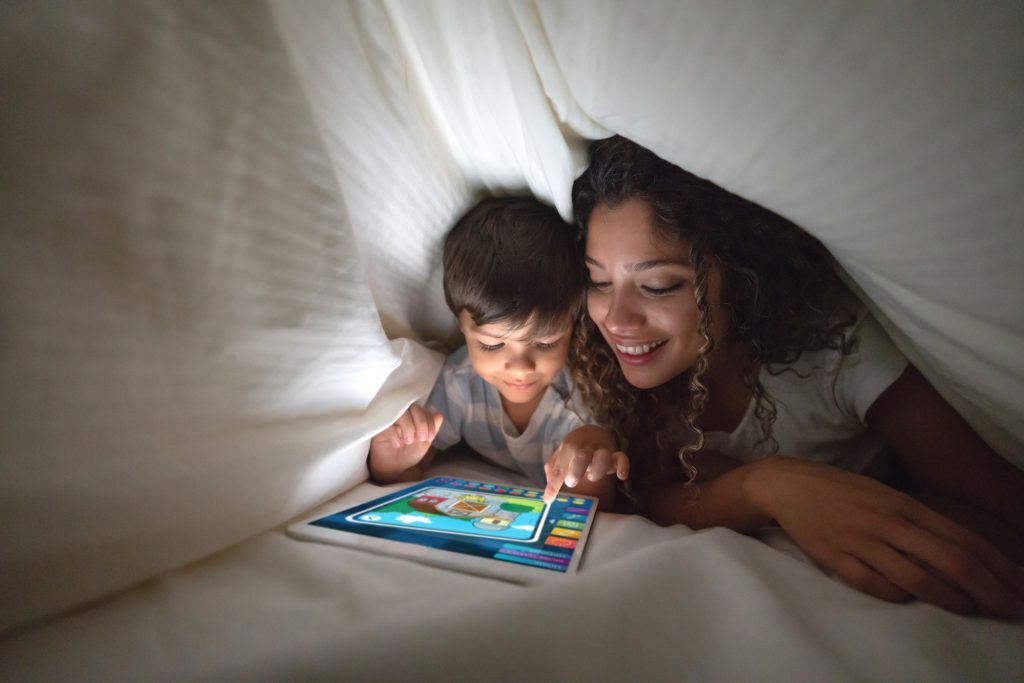As families everywhere adjust to social distancing measures like closed schools and child care centers, workplaces and more, parents are grappling with questions regarding their kids’ use of technology. Rebecca Dore, an expert on children and media, offers some tips for how to make the most of screen time for kids who are cooped up at home.
1. Choose high-quality educational media
Rather than handing over the remote or the iPad, parents can help young children by choosing media that’s worthwhile. By the time children are about age 3, high-quality media like “Sesame Street” can help them learn about words, numbers and even important facts about how to stay safe, research has shown.
Kids can also learn from apps, such as Bedtime Math (which has been shown to have long-term effects on children’s math skills), Measure That Animal (a “Sesame Street” game focused on improving children’s measuring skills) and D.W.’s Unicorn Adventure (which uses a fantasy game to teach about healthy foods).
This all means that screen time doesn’t just have to be a way to keep your child occupied while you send some emails or tend to household chores. But where can you find high-quality educational media?
Resources like Common Sense Media provide research-based information and ratings about all types of media for kids of all ages. They even have a special page to help families during the coronavirus pandemic. Shows and apps from PBS KIDS are all based on child development research and a search tool on their website lets you choose your child’s age and a topic area to search for appropriate media. It also provides related activities that can be done both online and without a device.
Another way to tie learning and screen time is to follow your child’s interests and find educational media to match whatever they are obsessing over. If 6-year-old Robby is begging to make pancakes for breakfast now that he’s not rushing off to school, find a video that shows the science behind how baking soda makes those pancakes extra fluffy.
If you have small kiddos at home & internet access, @PBSKIDS has a wide range of FREE educational games. Here are some about space & Earth science: https://t.co/VMem9O5pwa Funded by @CPBmedia & @PBS, your public media. Each has curated science curriculum from me & ed experts. pic.twitter.com/Mwryyl23TD
— Amy Mainzer (@AmyMainzer) March 14, 2020
2. Use media with children
Although adults often use media as a babysitter, young children get more out of it when they use it with an adult. Grownups, after all, can help them understand what’s going on and make connections to the real world. One study found that when 3-year-olds watched a “Dora the Explorer” episode, 75% of them thought the Spanish words in the show weren’t real or said they weren’t sure if they were real.
Not surprisingly, those children were less likely to learn from the show.
Parents can help by watching with children, talking to them about what they are seeing and linking it to their everyday lives. For example, a mom or dad can observe that “Dora speaks Spanish, like your friend Mateo from school.”
Making the time and effort to do this is always easier said than done – especially when kids are home from school and need to be entertained around the clock while their parents are nearby teleworking. But even when you feel like you have no time or energy to watch, listen or play together, there are some ways you can fit some of what experts call “joint media engagement” into a busy schedule.
Have your 4-year-old listen to an e-book at the kitchen table while you’re making dinner. You can pay attention and then talk about it afterwards with your child. Or listen to an age-appropriate podcast together while you’re folding laundry instead of setting your child up with a TV show in the other room.
3. Find ways to create, rather than consume
Kids can do more than merely use, play with and watch media created by others. Instead, they can use technology in creative and imaginative ways.
For example, tech can help them write their own songs or create works of art. Children can also use smartphones, tablets or computers to create their own videos to share with family and friends. They can have fun filming themselves acting out a play or make an instructional video to teach a grandparent how to play their favorite video game.
- is Senior Research Associate in Early Childhood, The Ohio State University
- This article first appeared on The Conversation




